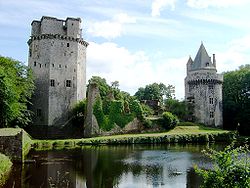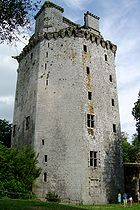
Château de Largoët
Encyclopedia

Elven, Morbihan
Elven is a French commune, located in the department of Morbihan and region of Brittany.-Geography:The village of Elven is located about 15 km from the Vannes-Rennes junction on route nationale 166 and is the capital of the canton of Elven which also includes Saint-Nolff, Monterblanc,...
, in the Morbihan
Morbihan
Morbihan is a department in Brittany, situated in the northwest of France. It is named after the Morbihan , the enclosed sea that is the principal feature of the coastline.-History:...
département of France
France
The French Republic , The French Republic , The French Republic , (commonly known as France , is a unitary semi-presidential republic in Western Europe with several overseas territories and islands located on other continents and in the Indian, Pacific, and Atlantic oceans. Metropolitan France...
, 13 km from Vannes
Vannes
Vannes is a commune in the Morbihan department in Brittany in north-western France. It was founded over 2000 years ago.-Geography:Vannes is located on the Gulf of Morbihan at the mouth of two rivers, the Marle and the Vincin. It is around 100 km northwest of Nantes and 450 km south west...
.
History

Breton War of Succession
The Breton War of Succession was a conflict between the Houses of Blois and Montfort for control of the Duchy of Brittany. It was fought between 1341 and 1364. It formed an integral part of the early Hundred Years War due to the involvement of the French and English governments in the conflict; the...
, before it came to the Rieux family in the 15th century. It was during this period (between 1474 and 1476) that Jean IV, lord of Rieux, protected Henry Tudor, Duke of Richmond, future King Henry VII
Henry VII of England
Henry VII was King of England and Lord of Ireland from his seizing the crown on 22 August 1485 until his death on 21 April 1509, as the first monarch of the House of Tudor....
of England
England
England is a country that is part of the United Kingdom. It shares land borders with Scotland to the north and Wales to the west; the Irish Sea is to the north west, the Celtic Sea to the south west, with the North Sea to the east and the English Channel to the south separating it from continental...
. In 1490, Charles VIII of France
Charles VIII of France
Charles VIII, called the Affable, , was King of France from 1483 to his death in 1498. Charles was a member of the House of Valois...
, dismantled the castle, but it was restored under the influence of Anne de Bretagne.
Nicolas Fouquet
Nicolas Fouquet
Nicolas Fouquet, marquis de Belle-Île, vicomte de Melun et Vaux was the Superintendent of Finances in France from 1653 until 1661 under King Louis XIV...
bought it in 1656 and, after his death, it was sold to Michel de Trémeurec and stayed in his family. In the 19th century, it was proposed to demolish Largoët, given its dilapidation, but it was saved thanks to Prosper Mérimée
Prosper Mérimée
Prosper Mérimée was a French dramatist, historian, archaeologist, and short story writer. He is perhaps best known for his novella Carmen, which became the basis of Bizet's opera Carmen.-Life:...
, who had it classed as a monument historique
Monument historique
A monument historique is a National Heritage Site of France. It also refers to a state procedure in France by which national heritage protection is extended to a building or a specific part of a building, a collection of buildings, or gardens, bridges, and other structures, because of their...
in 1862. Beginning in the 1970s, there has been a programme of restoration.
Architecture
The ruins of Largoët maintain their imposing aspect, notably because of the 14th century octagonal keepKeep
A keep is a type of fortified tower built within castles during the Middle Ages by European nobility. Scholars have debated the scope of the word keep, but usually consider it to refer to large towers in castles that were fortified residences, used as a refuge of last resort should the rest of the...
. At 45 m, it is one of the highest in France (for comparison, the keep at the Château de Vincennes
Château de Vincennes
The Château de Vincennes is a massive 14th and 17th century French royal castle in the town of Vincennes, to the east of Paris, now a suburb of the metropolis.-History:...
reaches 52 m). There are five floors and the walls are between 6 and 10 m thick. On the sixth or seventh floor is the room where Henry Tudor stayed .
As well as this colossal edifice, Largoët also boasts:
- A 15th century gatehouseGatehouseA gatehouse, in architectural terminology, is a building enclosing or accompanying a gateway for a castle, manor house, fort, town or similar buildings of importance.-History:...
, marking the entrance to the fortress, built against another 13th century building. - A round tower of three storeys, from the 15th century, with cannon openings on the first level, and covered with a hexagonal building. It was furnished in the 20th century as a hunting lodge. It has been used as a location for historical films, including Lancelot du LacLancelot du Lac (film)Lancelot du Lac is 1974 film that was written and directed by Robert Bresson. It relates the story of Lancelot and Guinevere's love as Camelot and the Round Table fall apart...
and Chouans. - The remains of the enclosing walls, dried up moats and a lake.
- The ruins of a construction known as an ice house (glacière), used as a food store.
- The entrance to a vast cellar which was used to store wood.

